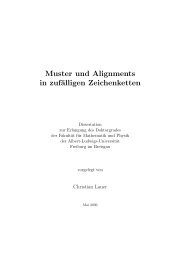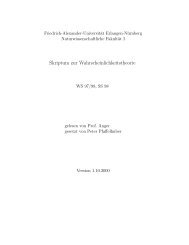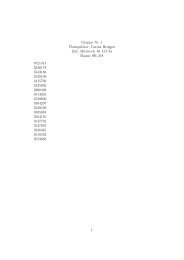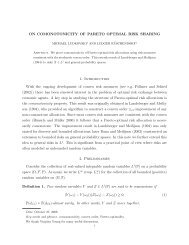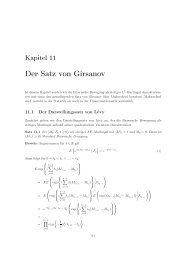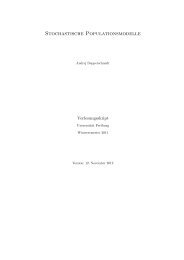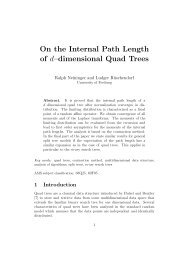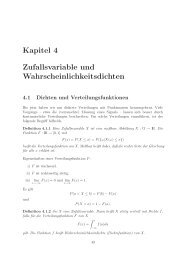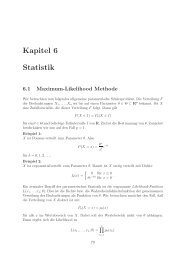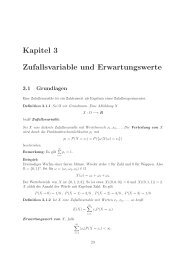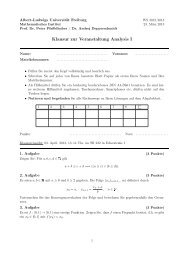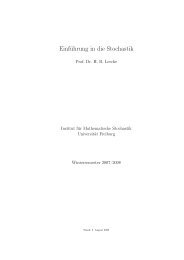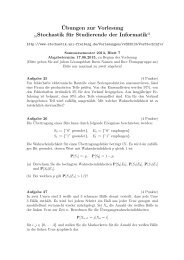Analysis of Markov chain algorithms on spanning trees, rooted ...
Analysis of Markov chain algorithms on spanning trees, rooted ...
Analysis of Markov chain algorithms on spanning trees, rooted ...
Create successful ePaper yourself
Turn your PDF publications into a flip-book with our unique Google optimized e-Paper software.
J. Fehrenbach and L. Rüschendorf 3<br />
for any Ω i . This property is called self-reducibility in Jerrum et al. (1986).<br />
But the challenge is c<strong>on</strong>diti<strong>on</strong> d) for Ω = Ω 0 The main tool for c<strong>on</strong>structing<br />
approximatively uniform samples is to c<strong>on</strong>struct a suitable <str<strong>on</strong>g>Markov</str<strong>on</strong>g> <str<strong>on</strong>g>chain</str<strong>on</strong>g> M<br />
which has as its stati<strong>on</strong>ary distributi<strong>on</strong> the uniform distributi<strong>on</strong> <strong>on</strong> Ω. (A<br />
well-known applicati<strong>on</strong> <str<strong>on</strong>g>of</str<strong>on</strong>g> this method is the simulated annealing algorithm.)<br />
The main technical problem is to establish that the used <str<strong>on</strong>g>Markov</str<strong>on</strong>g> <str<strong>on</strong>g>chain</str<strong>on</strong>g> is<br />
rapidly mixing. This property then yields that sampling can be d<strong>on</strong>e efficiently<br />
(in polynomial time). Several tools have been developed to this aim. The main<br />
tools are various eigenvalue estimates for the sec<strong>on</strong>d largest eigenvalue <str<strong>on</strong>g>of</str<strong>on</strong>g> the<br />
transiti<strong>on</strong> matrix (Diac<strong>on</strong>is and Stroock (1991)), coupling methods (see e.g.,<br />
Aldous (1983) or Diac<strong>on</strong>is (1988)) the c<strong>on</strong>ductance method and the method <str<strong>on</strong>g>of</str<strong>on</strong>g><br />
can<strong>on</strong>ical paths (see Diac<strong>on</strong>is and Stroock (1991) and Sinclair (1993)). Here the<br />
basic idea to obtain a good upper bound <strong>on</strong> the mixing time <str<strong>on</strong>g>of</str<strong>on</strong>g> the <str<strong>on</strong>g>Markov</str<strong>on</strong>g><br />
<str<strong>on</strong>g>chain</str<strong>on</strong>g> is to select a set Γ = {γ xy ; x, y ∈ Ω} <str<strong>on</strong>g>of</str<strong>on</strong>g> can<strong>on</strong>ical paths γ xy for each<br />
pair (x, y) such that no transiti<strong>on</strong> e = (v, w) <str<strong>on</strong>g>of</str<strong>on</strong>g> the graph <str<strong>on</strong>g>of</str<strong>on</strong>g> the <str<strong>on</strong>g>chain</str<strong>on</strong>g> is too<br />
<str<strong>on</strong>g>of</str<strong>on</strong>g>ten used in the corresp<strong>on</strong>ding flow problem. Define the c<strong>on</strong>gesti<strong>on</strong> measure<br />
ϱ = ϱ(Γ) by<br />
ϱ(Γ) =<br />
max<br />
e=(v,w)∈E<br />
1<br />
π(v)P (v, w)<br />
∑<br />
(x,y):γ xy∋e<br />
π(x)π(y)|γ xy |. (1.5)<br />
Here P (v, w) is the transiti<strong>on</strong> matrix <str<strong>on</strong>g>of</str<strong>on</strong>g> the <str<strong>on</strong>g>Markov</str<strong>on</strong>g> <str<strong>on</strong>g>chain</str<strong>on</strong>g>, π is the stati<strong>on</strong>ary<br />
distributi<strong>on</strong> and |γ xy | is the length <str<strong>on</strong>g>of</str<strong>on</strong>g> the path γ xy . The sum term is the total<br />
flow through edge e while the first term is the inverse capacity <str<strong>on</strong>g>of</str<strong>on</strong>g> edge e. By<br />
a result <str<strong>on</strong>g>of</str<strong>on</strong>g> Diac<strong>on</strong>is and Stroock (1991) <strong>on</strong>e obtains for irreducible, aperiodic,<br />
reversible <str<strong>on</strong>g>Markov</str<strong>on</strong>g> <str<strong>on</strong>g>chain</str<strong>on</strong>g>s with P (x, x) ≥ 1 for all x ∈ Ω the following estimate<br />
2<br />
<str<strong>on</strong>g>of</str<strong>on</strong>g> the mixing time τ = τ(ε):<br />
τ(ε) ≤ ϱ(Γ)(log ̂π −1 + log ε −1 ) (1.6)<br />
with ̂π = min x∈Ω π(x). So the problem to bound the mixing time <str<strong>on</strong>g>of</str<strong>on</strong>g> the <str<strong>on</strong>g>Markov</str<strong>on</strong>g><br />
<str<strong>on</strong>g>chain</str<strong>on</strong>g> can be reduced to obtain bounds <strong>on</strong> the c<strong>on</strong>gesti<strong>on</strong> measure. Note that<br />
for the uniform distributi<strong>on</strong> π the term log ̂π −1 is polynomial in n, when as<br />
typically N = |Ω| is exp<strong>on</strong>ential in n.<br />
To obtain bounds <strong>on</strong> ϱ(Γ) an important technique is coding <str<strong>on</strong>g>of</str<strong>on</strong>g> the transiti<strong>on</strong>s<br />
<str<strong>on</strong>g>of</str<strong>on</strong>g> the can<strong>on</strong>ical path. For e ∈ T = {(x, y) ∈ Ω × Ω : P (x, y) > 0}<br />
define P c (e) = {(x, y) ∈ Ω × Ω : γ xy ∋ e}, the set <str<strong>on</strong>g>of</str<strong>on</strong>g> pairs whose can<strong>on</strong>ical<br />
path uses edge e. Then a coding is a system (η e ) <str<strong>on</strong>g>of</str<strong>on</strong>g> injective mappings<br />
η e : P c (e) → Ω, e ∈ T . If π is the uniform distributi<strong>on</strong> <strong>on</strong> Ω and (η e ) a coding,<br />
then we obtain the estimate<br />
ϱ(Γ) =<br />
≤<br />
≤<br />
max<br />
e=(v,w)∈T<br />
max<br />
e=(v,w)∈T<br />
max<br />
e=(v,w)∈T<br />
1<br />
π(v)P (v, w)<br />
l max<br />
P (v, w)<br />
l max<br />
P (v, w)<br />
∑<br />
(x,y)∈P(e)<br />
∑<br />
(x,y)∈P(e)<br />
π(x)π(y)|γ xy | (1.7)<br />
π(η e (x, y))



